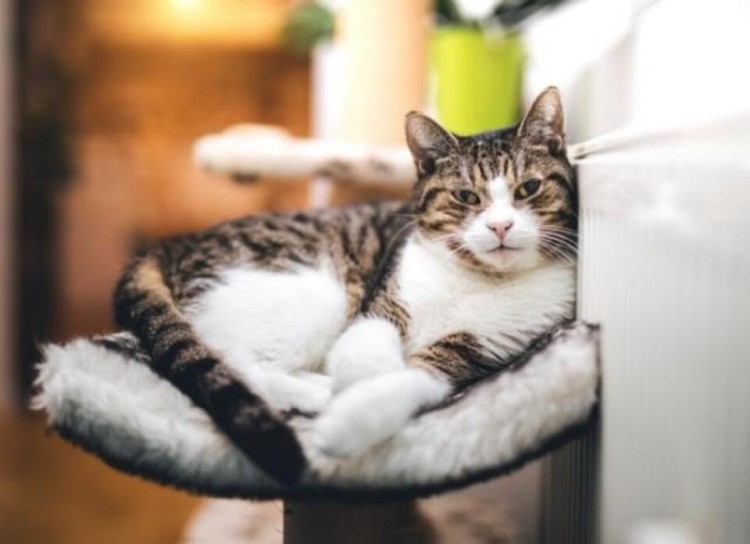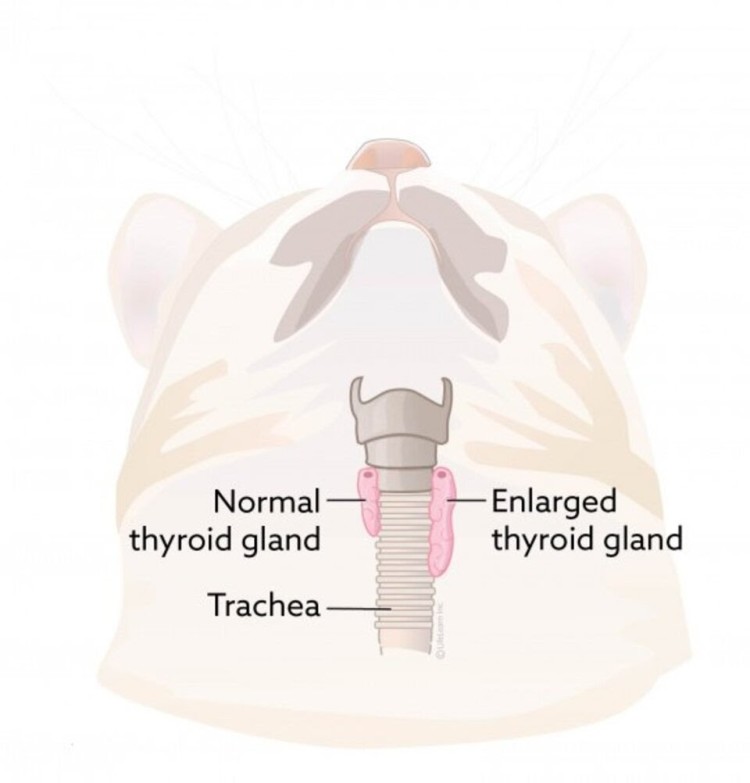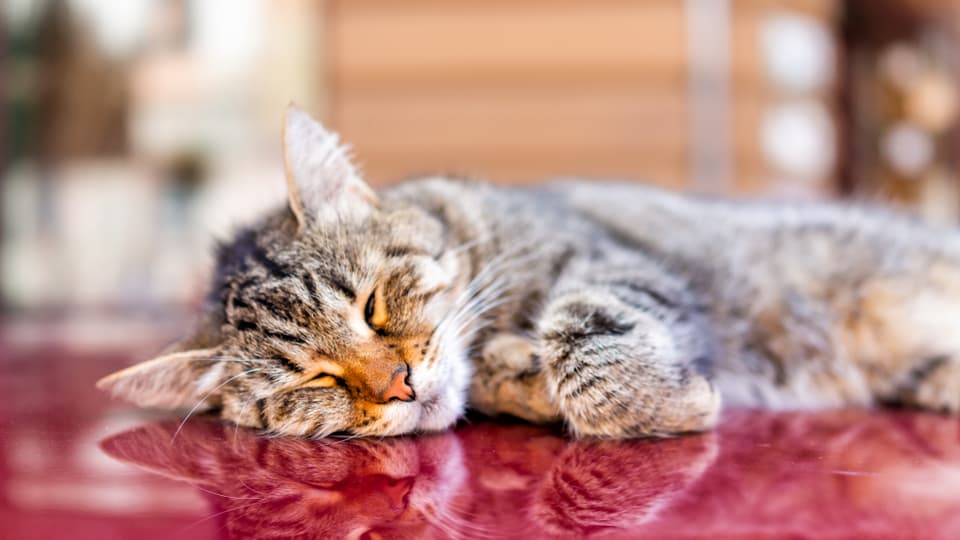Hyperthyroidism (overactive thyroid) is the most common endocrine disorder in cats, usually affecting older pets. The condition is caused by an excess release of thyroid hormones, which can have a significant impact on your pet’s health as these hormones regulate metabolic processes in the body.
If you are worried that your pet may have feline friend hyperthyroidism, in this guide you will find everything you need to know about this condition so that you can recognize the symptoms and get appropriate treatment for your pet.
Table of Contents:
- What is hyperthyroidism in cats?
- What causes hyperthyroidism in cats
- How to treat hyperthyroidism in cats
- What if feline hyperthyroidism is left untreated?
- Can feline hyperthyroidism be prevented?
- Key Takeaways
Pro tip: Diagnosis and treatment for feline hyperthyroidism can be quite expensive, but a good pet insurance plan can help you manage the costs. It can also cover your cat for other common illnesses, as well as injuries and accidents.
 (Image source: PetMD)
(Image source: PetMD)
What is hyperthyroidism in cats?
In felines, the thyroid gland is made up of two parts, one located on either side of its windpipe. These glands produce hormones that help regulate the metabolic rate. With hyperthyroidism, the thyroid glands release excess levels of thyroid hormones, speeding up the body's metabolism and, as a result, causing stress to your pet’s internal organs, negatively impacting its overall health.
The thyroid glands produce two iodine-containing hormones, T3 and T4, which affect a number of processes in the cat’s body, including:
- Metabolism of carbohydrates and fats
- Body temperature regulation
- Weight loss and gain
- Cardiac output and heart rate
- Brain development and growth in young kittens
- Nervous system function
- Skin condition
- Muscle tone
- Reproduction
What causes hyperthyroidism in cats?
There’s no known genetic predisposition for hyperthyroidism in cats, but it’s very common. It can occur in any breed of cat, female or male, but it is most common in older ones. The possible age range of diagnosis is 4 to 20 years, even though seeing the condition in young cats is rare. Less than 6% of cases are under 10 years of age. The average age of diagnosis is 12-13 years.
Even though no individual breed is known to be at a higher risk, Burmese, Siamese, Persian, Himalayan, and Abyssinian breeds seem to have a somewhat decreased incidence of the disease in comparison to other cat breeds.
Exposure to high dietary iodine levels may cause susceptible felines to develop hyperthyroidism. Some studies have established a link between hyperthyroidism in felines to some canned foods that contain fish, while others have pointed to PBDEs (flame-retardant chemicals) found in some carpeting and furniture cleaners.
In rare cases, the condition can be caused by thyroid cancer.
Symptoms of Hyperthyroidism in Cats
Some of the most common signs of feline hyperthyroidism include:
- Increased appetite
- Excessive thirst or excess drinking
- Weight loss
- Unkempt coat which might appear matted, dull, or greasy
- Thickened nails
- Diarrhea
- Vomiting
- Changes in behavior like not sleeping at night, aggression, restlessness, or hyperactivity
- Urinating more than usual
- Difficulty breathing
- Rapid breathing
- Abnormal heartbeat (“gallop rhythm”)
- Heart murmur (heart sounds produced when blood is pumped across a heart valve)
- Enlarged thyroid gland (feels like a lump on the cat’s neck)
Some hyperthyroid cats (less than 10%) will exhibit signs like weakness, loss of appetite, poor appetite, and depression.
Diagnosing Hyperthyroidism in Cats
Diagnosing hyperthyroidism in felines is generally quite straightforward as there will be high thyroid hormone levels in the bloodstream. However, in some cats, thyroid hormone levels might be within the normal range (especially in the early stages of the disease), which makes the diagnosis more complicated.
If your feline friend is manifesting the typical clinical signs but the blood test results are inconclusive, your vet will want to perform additional blood tests or they might recommend a thyroid scan. The symptoms of hyperthyroidism in cats can sometimes be similar to those of chronic hepatic disease, diabetes, chronic kidney failure, and some types of cancer (usually intestinal lymphoma). In order to exclude these conditions, your vet will use thyroid function tests - a series of blood tests used to measure how well the cat’s thyroid gland is working - along with routine lab findings.
 (Image source: VCA Animal Hospital)
(Image source: VCA Animal Hospital)
How to treat hyperthyroidism in cats?
There are several ways to treat your cat's hyperthyroid condition. Here is a look at some of the most common options your vet might recommend.
Methimazole Medication
Methimazole is one of the most common treatment choices in hyperthyroid cats. This medicine is often given before radioiodine therapy or surgery in order to control your pet’s symptoms. However, methimazole is only effective in stabilizing the clinical signs and doesn’t cure the condition, which means that your kitty will have to receive it for the rest of the life. If your pet is under ten years old, the cost of this medication for a lifetime could exceed radioiodine therapy or surgery.
Methimazole is administered orally in pill form or it can be formulated into a transdermal gel that’s applied to the animal’s ear. The medication rarely causes adverse side effects, but when it does, these side effects can be quite severe. For that reason, you will need to make regular monitoring appointments with your vet.
Radioiodine Therapy
Vets usually prescribe radioiodine treatment (radioactive iodine therapy or I131) which can successfully cure the disease in most cases. This therapy uses radioactive iodine to destroy the affected tissue in the thyroid gland and most felines are cured with only one treatment. This treatment is only offered in certain speciality veterinary hospitals so check with your vet to see if it is an option in your area.
After treatment, the pet’s thyroid levels are monitored. Recurrence isn’t common after the treatment, but it’s possible and can be managed with daily medication.
As the therapy is radioactive, it can only be used in confined medical facilities. This means that your feline friend will have to be admitted to a hospital for several days or weeks after treatment so that the radioactive material can leave its body before returning home. Once your kitty is home, your vet will provide instructions in order to minimize the risk of exposure to the radioactive material for other members of the household.
If radioiodine therapy is not an option due to your pet’s overall health or for financial reasons, your vet might prescribe an iodine-restricted diet or daily doses of methimazole as an alternative.
Low-Iodine Diet
An iodine-restricted diet is a relatively new alternative for treating hyperthyroidism in cats. A pet on this diet cannot be given other cat food, human food, or treats. If other cats in the household eat this food, they’ll need supplemental nutrients that can provide adequate iodine.
Similar to the methimazole treatment, an iodine-restricted diet won’t cure the disease and your feline friend will require lifelong treatment. The results of these diets are variable, so check with your vet to see if they believe it's in your cat's best interest.
Surgery
Like radioactive iodine treatment, surgical removal of the diseased thyroid gland can be curative.
This surgery is best performed when only one of the thyroid glands is affected, as removing both of them could result in hypothyroidism, in which case decreased thyroid hormone levels result in a slower metabolic rate.
Another possible complication to expect after the procedure is hyperactivity of the remaining thyroid gland.
What if feline Hyperthyroidism is left untreated?
This condition can be easily missed since felines tend to hide when they are not feeling well or mask symptoms of illness. In addition, hyperthyroidism can be overlooked because it usually occurs in senior pets who might already have other health problems with similar clinical signs.
As mentioned earlier, thyroid hormones affect almost all of the organs in the body and if the disease is left untreated, it can lead to serious health issues or even death. For example, hyperthyroidism can cause increased heart rate which, over time, can obstruct the normal functioning of the heart and result in cardiac arrest.
Thyroid hormones can also cause high blood pressure (hypertension) and cause damage to the kidneys, brain, and eyes. In addition, kitties with untreated hyperthyroidism have a lower quality of life, and some might even endure pain due to the symptoms of the disease.
Feline hyperthyroidism is commonly diagnosed along with renal (kidney) disease. Kitties suffering from both conditions might need treatment for both. The diagnosis of renal disease in a pet suffering from hyperthyroidism can also influence the prognosis.
Pro tip: Hyperthyroidism in cats must be treated as quickly as possible using the most suitable treatment plan prescribed by a vet. If you’re worried about unexpected costs, taking out a pet insurance policy can help put those worries to rest. With the right health insurance plan, your vet bills will be covered and you can arrange the best care for your cat without worrying about unexpected expenses.
 (Image source: Soft Paws)
(Image source: Soft Paws)
Follow-Up Care
Your feline friend will need to be re-examined by a vet every 3-4 weeks during the first 3 months of treatment. The vet will perform a complete blood count to check thyroid hormone levels in the blood. He will then adjust treatment in accordance with the results.
If your pet has undergone surgery, your vet will monitor its recovery and watch for complications, such as vocal cord paralysis or the development of low calcium levels in the blood. In the first week after the procedure and then every 3-6 months, the vet will also measure your pet’s thyroid hormone levels to see if there is a recurrence of thyroid gland overactivity.
The prognosis for hyperthyroid cats is generally good with appropriate therapy. The outcomes following most hyperthyroid treatments are usually very good, and most felines have a solid chance of returning to a normal state of health. Pets managed with medication or iodine-restricted diet generally do well so long as their medication is administered regularly or their feeding is consistent, and follow-up tests are performed as scheduled. In some cases, complications involving other organs might affect the prognosis.
Can hyperthyroidism in cats be prevented?
Early diagnosis improves the prognosis and reduces the risk of secondary health issues. Older felines should get a complete physical exam by a vet every 6 months, paying special attention to the thyroid glands. Urine and blood tests should be performed annually in all cats over the age of 6 in order to detect hyperthyroidism before more serious damage occurs.
If your feline friend is diagnosed with hyperthyroidism, your vet will help you determine the best course of action.
Key Takeaways
- Feline hyperthyroidism refers to an overproduction of hormones in the thyroid gland.
- The condition is very common in senior cats.
- Symptoms can include weight loss, increased appetite, and poor coat appearance.
- The condition can be easily diagnosed by a vet with a blood test.
- Pet health insurance can help owners cover the cost of their cat's treatment and care.
